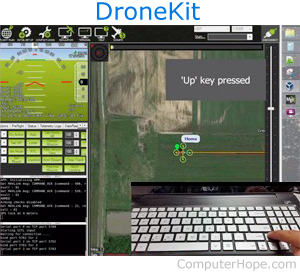Drone

Also known as a UAV (unmanned aerial vehicle), a drone is a flying device that is controlled remotely by a user. Drones fly using multiple propellers mounted on arms that extend from the center. Most drones have cameras mounted on them to capture photos or record videos from the air. Drones can be piloted via a proprietary controller or a smartphone app.
Drone was featured as a top term of 2006.
Uses of drones
Today, drones are commonly used for the following tasks:
- Capturing aerial stock photos and videos.
- Filming movie scenes and other commercial footage.
- Surveying and protecting dangerous territory in war zones.
- Monitoring activity on private property.
- Searching for missing people in remote locations.
- Competitive drone-based spectator events, like the Drone Racing League.
- Product delivery via drone is being tested by e-commerce companies, like Google and Amazon.
History of drones
As a drone is technically any unmanned aerial vehicle, the first use of a drone was in 1839. Austrians used unmanned balloons to attack Venice with explosives. Unfortunately, the Austrians relied on wind to carry the balloons to Venice, and in some cases, the wind blew the balloons back towards the Austrian lines and ended up bombing themselves.
Drones as we know them today, the small remotely controlled drones, began to see increasing use starting in 2006. Because of the increased usage, the FAA (Federal Aviation Administration) began issuing commercial drone permits for drone use in 2006, as well.
Popularity of drones grew rapidly beginning in 2013, when Amazon.com announced they were looking into the ability to use drones for delivering packages to their customers.
How to control drones with a computer or smartphone

UAVs can be controlled with a computer to achieve autonomous flight, or pre-programmed flight plans. The computer may also be used as a remote control ground station. Some apps can control UAV flight, and turn a smartphone into a drone with special hardware.
Below are examples of apps, open-source software, and communities that support programmable and computer-controlled UAV flight.
- ArduPilot — Autopilot software for Arduino-controlled aerial planes and copters, ground-based rovers, and water-based RC (remote control) subs.
- CleanFlight — Flight control software with a focus on support for the most modern flight hardware.
- DroneCode — A complete UAV solution with a focus on serving larger organizations.
- DroneKit — An API (application programming interface) in the Python programming language used to communicate with drones using the MAVLink protocol.
- DronePan — An app for iOS that helps you take 360-degree panoramic photos using select drone models.
- dRonin — A software stack for autonomous drone flight and FPV (first-person view) racing.
- Flone — An app and hardware kit that turns an Android smartphone into a drone, which can be controlled by a second Android device.
- Intel Aero — An autonomous flight software package in the Python programming language, developed by Intel.
- LibrePilot — Software and hardware for control, stabilization, remote control, and autonomous piloting of UAVs.
- NVIDIA Redtail — Software for piloting drones and rovers autonomously through unstructured terrain, developed by NVIDIA.
- PX4 Autopilot — A software stack for piloting UAVs, and information about how to build one from scratch.
- PaparazziUAV — Autopilot systems and ground station software for aerial and ground-based UAVs.
